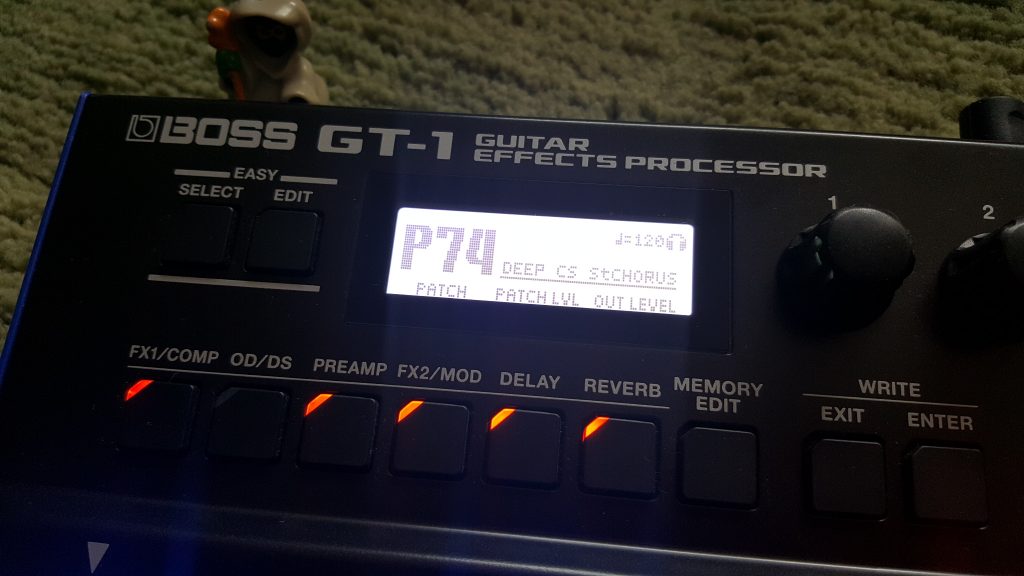

With eight stomps (or seven and a tuner) and a wah/volume pedal, the BOSS GT-100 could be all you need between your guitar and amp.
Gt 100 patch exchange manual#
You might not want to use the amp sims in a live situation but there are myriad effects on tap, particularly in manual mode, which instantly transforms the unit from a patch-based multi-effects unit to effectively being a pedalboard full of individual stompboxes. It's a great resource of tones for recording, utilising a full range of amp and effect sounds and it's also a very practical onstage unit.
Gt 100 patch exchange series#
The GT-100 advances the abilities and practicalities of the GT series while also being a lot easier to set up and use than its forebears. The Phrase Loop pedal offers simple record/play/overdub control of the looper, which, while rudimentary, offers a useful facility, particularly for practice. It can also be assigned as a tap-tempo switch and, if you need even more control there's the option of adding an external expression pedal and footswitches. In addition, although the ACCEL pedal is capable of a range of off-the-wall spot effects including feedback and ring modulation, it can also be assigned as a control pedal to a patch parameter and is extremely useful designated as a simple boost or as a switcher between channels A and B if you are using a patch with two channels. The heavy-duty expression pedal facilitates control over volume and can also offer wah or Whammy-style pitch bending. In terms of playability, the COSM amp simulations do seem nicely responsive to touch, doubtless benefiting from the increase in DSP power, and, underfoot, you get arange of options to enhance performance. There are some very inspiring sounds among the presets that will make you want to play as well as providing massive potential for creating your own tones. The upshot of all these options, combined with the mass of available editing opportunities, is that the GT-100 is capable of a very wide range of tones as evidenced by the factory presets, which run from meat and potatoes amp simulation right through to esoteric effects that show the full sonic capabilities of the unit. The two FX blocks have access to 32 different effects including plenty of modulation, pitch shifting and filter options. There are 26 amp simulations including Fender, Marshall and other well-known brands/models, while the overdrive/distortion block has 22 options including emulations of a Rat, Big Muff, Fuzz Face and Tube Screamer. The associated amp customise and OD/DS customise functions do the same for amp type and overdrive/distortion type.Įach of the blocks in the signal chain can have a variety of different modelled sounds loaded into it. The EZ Tone function enables you to choose a basic musical style and tailor it by moving a cursor in a graphical grid. Instead of getting straight in and tweaking individual parameters, you can also paint your sound using broader strokes.
Gt 100 patch exchange windows#
Several pages of parameters can be easily brought into the display windows by using a pair of page buttons below the knobs. The remarkable thing is that there are no conventional menus to wade through - everything is on the surface and on display.Įach of the two displays has four soft knobs beneath it to edit whichever parameter is graphically on show.

Setting up and storing your own patches/pedalboard configurations before playing is obviously the way to go and BOSS has really made that a simple process here. You could easily choose adifferent set of effects onstage between songs, or even during a song, with some deft footwork on the bank buttons.

In this way, each patch can give you a different array of 'pedals' for your pedalboard - up to eight stompboxes and a pedal effect. In this mode the GT-100 can function just like a conventional pedalboard with the switches being instantly assigned to individual on/off switching of the effects in whatever patch is selected. While you could simply operate the GT-100 by changing patches at appropriate points in each song, there's an alternative manual mode, entered by pressing both bank switches simultaneously. The fifth footswitch operates the looper while the sixth is the previously mentioned ACCEL switch. Two upper footswitches select the patches, one scrolling up the list, the other down, while the first four of the lower bank of footswitches select the patches within the bank.


 0 kommentar(er)
0 kommentar(er)
